9 NOVEMBER 2009
YOUR WORDS
Readers are invited to add their comments to any story. Click on the article to see and add.
BTN DISTRIBUTION
BTN also goes out by email every Sunday night at midnight (UK time). To view this edition click here.
- COMMENT: Visit World Travel Market
- Aer Lingus ups London services
- Air New Zealand replaces fleet
- Australian operator for Gatwick
- bmibaby restructures
- British Airways problems
- Continental finally goes flat
- Cyprus opens new terminal
- Dubai Airshow
- First UK Embraer Phenom
- Iberia attacked by The Independent
- Ibis for Northern Ireland
- London to gain major new hotel?
- OAG November figures
- Olympic hotel added for London
- Qantas and Hong Kong
- Ryanair profits
- SkyTeam at Heathrow
- Travelodge to open seven hotels before Christmas
- United to Africa
- Yas hotel
- TOM WHEATCROFT
- ON TOUR: Supersonic private jets
- MOTORING UPDATE by Ted Wilkinson
- HAPPY TALK: Sharp Story
The Business Travel News
PO Box 758
Edgware HA8 4QF
United Kingdom
info@btnews.co.uk
© 2022 Business Travel News Ltd.
Air New Zealand replaces fleet
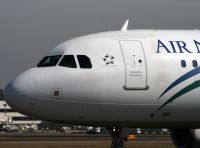 AIR NEW ZEALAND has ordered 14 Airbus A320 aircraft to replace its existing domestic fleet of 15 Boeing 737-300s. The aircraft will be powered by IAE engines. The A320, which is larger than the aircraft type it will replace, will enable Air New Zealand to increase capacity on routes that are starting to face capacity constraints at some airports during peak times. Air New Zealand has also placed purchase options for a further 11 A320 aircraft, including the possibility of selecting the larger A321. The order comes as no surprise with the carrier already a 12-strong Airbus A320 operator on short haul international sectors. www.airnewzealand.co.nz
AIR NEW ZEALAND has ordered 14 Airbus A320 aircraft to replace its existing domestic fleet of 15 Boeing 737-300s. The aircraft will be powered by IAE engines. The A320, which is larger than the aircraft type it will replace, will enable Air New Zealand to increase capacity on routes that are starting to face capacity constraints at some airports during peak times. Air New Zealand has also placed purchase options for a further 11 A320 aircraft, including the possibility of selecting the larger A321. The order comes as no surprise with the carrier already a 12-strong Airbus A320 operator on short haul international sectors. www.airnewzealand.co.nz
British Airways problems
 BRITISH AIRWAYS has announced a loss of £292m for the normally lucrative six (summer) months ending 30 September as against a £140m profit for the same period last year. Also announced last Friday (6 November) was a profit of €15m (£13.5) for Alitalia. Again on the financial front Lufthansa has reported a gain of €226m (£200m) for the first nine months of 2009. Air France says it will find it "very difficult" to meet its full-year profit target of €1bn (£802m) but should come out positive. To add to its woes the widely reported BA cabin staff dispute over cost cutting continues although the airline has won a court injunction allowing it to move ahead with its implementation. However the Union is still planning a strike ballot and whatever brave words BA puts out these problems will have an effect on forward bookings. www.unitetheunion.com www.ba.com
BRITISH AIRWAYS has announced a loss of £292m for the normally lucrative six (summer) months ending 30 September as against a £140m profit for the same period last year. Also announced last Friday (6 November) was a profit of €15m (£13.5) for Alitalia. Again on the financial front Lufthansa has reported a gain of €226m (£200m) for the first nine months of 2009. Air France says it will find it "very difficult" to meet its full-year profit target of €1bn (£802m) but should come out positive. To add to its woes the widely reported BA cabin staff dispute over cost cutting continues although the airline has won a court injunction allowing it to move ahead with its implementation. However the Union is still planning a strike ballot and whatever brave words BA puts out these problems will have an effect on forward bookings. www.unitetheunion.com www.ba.com
Dubai Airshow
 DUBAI’S AIRSHOW opens next Sunday (15 November) amid strong predictions that the Middle East region will lead the aerospace industry's economic recovery. Airbus has predicted that international air passenger traffic will grow 6.6% over the next decade, making it the world's fastest-growing region for aviation. It added that the number of aircraft serving the region would almost triple by 2028. Boeing too has asserted that air travel in the Middle East is stronger than in most global regions, reporting that the market is valued at $300bn over the next two decades, with a requirement for more than 1,700 commercial jets. Dubai Airshow is expected to attract up to 900 exhibitors from nearly 50 countries, plus some 50,000 visitors, an overall 10% increase over the previous event in 2007. The show runs until 19 November. www.dubaiairshow.aero
DUBAI’S AIRSHOW opens next Sunday (15 November) amid strong predictions that the Middle East region will lead the aerospace industry's economic recovery. Airbus has predicted that international air passenger traffic will grow 6.6% over the next decade, making it the world's fastest-growing region for aviation. It added that the number of aircraft serving the region would almost triple by 2028. Boeing too has asserted that air travel in the Middle East is stronger than in most global regions, reporting that the market is valued at $300bn over the next two decades, with a requirement for more than 1,700 commercial jets. Dubai Airshow is expected to attract up to 900 exhibitors from nearly 50 countries, plus some 50,000 visitors, an overall 10% increase over the previous event in 2007. The show runs until 19 November. www.dubaiairshow.aero
Ibis for Northern Ireland
 IBIS, part of the French hotel group Accor, has opened two new city centre hotels in Belfast. The Ibis Belfast City Centre (124 rooms) is located on the corner of Castle Street in the downtown area of the city close to the main shopping district, Victoria Square – the city’s newest shopping haven, Titanic Quarter and the city’s Grand Opera House and Waterfront. Ibis Belfast Queens Quarter (50 rooms) is by Queen’s University on University Street, just a short walk from the newly re-opened Belfast City Hall and near the city centre. Each boasts a café and bar. www.ibishotel.com
IBIS, part of the French hotel group Accor, has opened two new city centre hotels in Belfast. The Ibis Belfast City Centre (124 rooms) is located on the corner of Castle Street in the downtown area of the city close to the main shopping district, Victoria Square – the city’s newest shopping haven, Titanic Quarter and the city’s Grand Opera House and Waterfront. Ibis Belfast Queens Quarter (50 rooms) is by Queen’s University on University Street, just a short walk from the newly re-opened Belfast City Hall and near the city centre. Each boasts a café and bar. www.ibishotel.com
Olympic hotel added for London
 INTERCONTINENTAL HOTELS GROUP (IHG) will have a second London property available in time for the Olympics with the announcement of the InterContinental London Westminster, set to open in late 2011. The 254-room six-storey hotel will occupy the former Queen Anne’s Chambers, originally built in the 19th century. The 120,000 sq ft freehold site close to New Scotland Yard, London’s Metropolitan Police headquarters, is currently office and retail space. The InterContinental London Park Lane was first opened in 1975, and reopened following extensive renovations in 2006 in celebration of the brand’s 60th anniversary. www.ichotelsgroup.com
INTERCONTINENTAL HOTELS GROUP (IHG) will have a second London property available in time for the Olympics with the announcement of the InterContinental London Westminster, set to open in late 2011. The 254-room six-storey hotel will occupy the former Queen Anne’s Chambers, originally built in the 19th century. The 120,000 sq ft freehold site close to New Scotland Yard, London’s Metropolitan Police headquarters, is currently office and retail space. The InterContinental London Park Lane was first opened in 1975, and reopened following extensive renovations in 2006 in celebration of the brand’s 60th anniversary. www.ichotelsgroup.com
SkyTeam at Heathrow
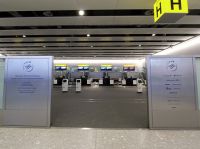 SKYTEAM has officially moved into its new facility at Heathrow Terminal 4. This includes an exclusive premium check-in area for First and Business Class passengers, Premium Economy travellers, as well as SkyTeam Elite and Elite Plus card holders. SkyTeam is the first airline alliance to unveil a permanent, single common facility in one terminal at Heathrow. For the first time, all SkyTeam co-located members will share airport services, including check-in desks, self-service kiosks, and bag drop off locations. The SkyTeam executive lounge, which opened in June, offers a variety of amenities including wine bar, oxygen bar and full-body massage chairs. Services on the second floor, which is now open, include a quiet room with day beds; two VIP rooms; and a separate children’s space with games and television. SkyTeam has also moved to Terminal 1 at Barcelona where it has similar facilities. www.skyteam.com
SKYTEAM has officially moved into its new facility at Heathrow Terminal 4. This includes an exclusive premium check-in area for First and Business Class passengers, Premium Economy travellers, as well as SkyTeam Elite and Elite Plus card holders. SkyTeam is the first airline alliance to unveil a permanent, single common facility in one terminal at Heathrow. For the first time, all SkyTeam co-located members will share airport services, including check-in desks, self-service kiosks, and bag drop off locations. The SkyTeam executive lounge, which opened in June, offers a variety of amenities including wine bar, oxygen bar and full-body massage chairs. Services on the second floor, which is now open, include a quiet room with day beds; two VIP rooms; and a separate children’s space with games and television. SkyTeam has also moved to Terminal 1 at Barcelona where it has similar facilities. www.skyteam.com
Yas hotel
 ABU DHABI FORMULA ONE TV watchers could not have failed to notice the Yas Hotel which literally overlooks the circuit. It comprises of 499 rooms and 14 entertainment and dining options in two separate buildings, connected by a bridge. An extraordinary 5000 LED panel Gridshell drapes the hotel enabling it to act as a light show providing different shades and colours, including animations, making it the largest colour LED display in the world. Inside the property, bespoke furniture, all created to fit the buildings’ unique shape and character, make the room designs distinctive and original. The bathrooms are housed in a frameless glass box, mounted with fine silk sheer panels. See Abu Dhabi adds hotel
ABU DHABI FORMULA ONE TV watchers could not have failed to notice the Yas Hotel which literally overlooks the circuit. It comprises of 499 rooms and 14 entertainment and dining options in two separate buildings, connected by a bridge. An extraordinary 5000 LED panel Gridshell drapes the hotel enabling it to act as a light show providing different shades and colours, including animations, making it the largest colour LED display in the world. Inside the property, bespoke furniture, all created to fit the buildings’ unique shape and character, make the room designs distinctive and original. The bathrooms are housed in a frameless glass box, mounted with fine silk sheer panels. See Abu Dhabi adds hotel
MOTORING UPDATE by Ted Wilkinson
VOLVO C30 1.6D SE STOP + START
Every Little Helps - a Lot!
 I have always recommended the Volvo C30 I for those motorists looking for a compact car with a more than a hint of quality. It is certainly one of best looking 3-door hatch backs around, especially when viewed from its rear which reminds me of the stylish 3-door Volvo 480ES, (produced from 1986 to 1995), notably the similarity of the one-piece glass tailgate.
I have always recommended the Volvo C30 I for those motorists looking for a compact car with a more than a hint of quality. It is certainly one of best looking 3-door hatch backs around, especially when viewed from its rear which reminds me of the stylish 3-door Volvo 480ES, (produced from 1986 to 1995), notably the similarity of the one-piece glass tailgate.
Clearly there are some more practical and roomier rivals, particularly when it comes to the rear accommodation. The limited luggage space is also compromised by both the high floor/tight aperture. 50/50 split folding rear seats can at least provides for say three adults and luggage.
Having re-established these factors the big news is that Volvo has recently seriously enhanced this car’s environmental status by the addition of a version equipped with the latest Stop and Start technology. And it is no gimmick!
The test example employed a similar mechanical package as my earlier test car, i.e. a 1.6-litre turbo diesel engine producing a useful 107.5 bhp and delivering the business through a five-speed manual gearbox but where that earlier car returned a range of about 565 miles between fuel stops this one, provided the system was fully exploited, could return up to a massive 857 miles!
What is more Volvo claim a 74.3 mpg combined fuel cycle and exemption from the dreaded Vehicle Excise Duty thanks to a sub 100 g/km figure.
However, nothing comes to he or she who does not deserve it and one has to ensure that the gear lever is in neutral when stationary to make the engine switch off. As soon as a gear is engaged the engine re-starts so the real bonus is gained by those who literally spend a lot of driving time in stop-start conditions rather than cruising the motorways. You do your bit and this car will do its.
Initially I found the situation a bit uncanny but with experience of this a Stop + Start systems on Audi, Toyota and Citroen cars I am getting accustomed to the way of life. I now hope that the car in front of me is also so equipped enabling me to benefit from the elimination of exhaust fumes when stuck in a jam.
That’s the bonus, the free lunch, the real benefit for a car that costs only about £1,500 more than the standard version.
As far as overall performance goes this 1.6SE turbo diesel version is probably sufficient for most drivers in the market sector, providing a claimed top speed of 118 mph with 62 mph (100 kph) reached in an acceptable 11.9 seconds allied to a frugal fuel consumption potential. I also found that the diesel unit proved quieter than the 1.6-litre petrol powered entry level version.
At the wheel I felt relaxed appreciating the comfortable driving position, the smart and logical fascia with its clear to see 4-dial instrumentation and a control layout proving every bit as good as the larger Volvos.
My comfort was achieved by a good combination of an adjustable lumber support, a tilt and reach adjustable steering column and good pedal spacing (but no footrest). Visibility from the driving seat is actually much better than the average hatch back.
The C30 is an entertaining drive thanks to good/light feel through the controls, a suspension system that takes variable road surfaces in its stride and also generates strong road grip, an insulated ride and effective braking qualities. Perhaps not that sporty a drive but immensely competent.
The basic car comes well equipped with items like alloy wheels, climate control air conditioning (with innovative carbon monoxide sensing/avoidance intake system), 4-speaker CD system automatic headlamp levelling and home safe lighting etc, the SE adds bigger wheels, automatic rain sensor windscreen wipers, steering wheel mounted audio controls and a rear spoiler etc.
Finish is to a very high standard, the test car featuring part leather trim and the interior trim features tasteful good quality materials while the build quality, as ever with a Volvo, should ensure long survival of the both car and its occupants.
Currently most of the car news is about electrically powered or hybrid models and probably this Stop and Start technology may be an interim phase but the fact it is here now and can deliver good results under the right conditions.
Other Stop + Start Contenders: Toyota Auris 1.3 TR Stop + Start £14,565, Citroen C2 Stop + Start ££11,156, Audi A5 Cabriolet 2.0 TFSI Stop + Start £30,880
STAR RATINGS
Performance 9
Handling 8
Transmission 8
Noise 9
Economy 10
Ride and Comfort 8
Accommodation 9
Styling 9
Brakes 9
Finish 9
TOTAL: 88%
Price: From £ 19,710
IN BRIEF
BMW: The BMW730Ld model has won the Professional Driver magazine’s Chauffeur Car of the Year award, beating rivals from Lexus and Mercedes-Benz. Judges particularly favoured the diesel powered car’s economy at a combined 40.9 mpg.
FORD: A voice control system is now available from as little as £150 on the Ford car range – standard on the top models, optional on the smaller models. The system can operate climate control, audio and satellite navigations systems.
LAMBORGHINI: The exotic Italian car producer has opened a further two dealerships in China, bringing representation to seven outlets.
LEXUS: Production has commenced on a 500-only run of a 575 bhp LFA super car powered by a 4.8-litre V10 engine redlined to an awesome 9,000 rpm and driving the rear wheels via a 6-speed sequential gearbox. UK price will be a massive £336,000.
MAZDA: According to used car evaluations experts CAP, the Mazda MP3 model has scored serious residual values boost of up to £750.
MITSUBISHI: An all-new on-road Crossover vehicle has been announced. Sales are due to begin in Japan in February 2010 and the first European viewing will be at the Geneva Motor Show in March 2010.
NISSAN: Buyers of new Nissan cars, ordered before 31 December 2009 and delivered by 31 March 2010 have been promised to have the impending VAT increase knocked off up to 2.5%.
SKODA: UK sales for the first three quarters of this year topped a recession-busting 25,000 cars and world-wide sales for the same period were 6.5% above those of the same period in 2008.
SUZUKI: A new 3-month deferred payment system has been launched enabling buyers of new models to beat the pending VAT rise due in January.
COMMENT: Visit World Travel Market
World Travel Market (WTM) is upon us once again, the 30th manifestation of what now competes with ITB as the world’s senior gathering of the international travel industry.
WTM does have two major advantages over the Berlin event. WTM is in a single building, with a 50% expansion due to open in May 2010.
Its other great benefit is Heathrow, the world’s busiest international airport, although with the present government’s passenger tax policy this may be now short lived. A classic example of how to destroy the goose that laid the golden egg. Ferrovial have not helped although there are some signs that the Spanish owners are beginning to realise British thinking is different to their own.
What is surprising is that British Airways, who must carry a major proportion of incoming visitors to the show and is an important player in the tourist trade, has no visibility at all at Excel.
It is not even possible to physically make a booking or change a flight reservation at the show. Only via internet. Global industry visitors cannot even talk to BA.
Yes it can be argued that a stand or kiosk is not cost effective but somehow BA management must be persuaded that it needs to be seen as part of the marketing/sales battle.
In what is proving to be the longest economic downturn since the end of the Second World War the travel industry somehow remains robust. Not for everyone. IATA continues to publish horrific figures concerning its members and delays to the A380, Boeing Dreamliner, and the A350 may have been bad news for the manufacturers, but in truth was just what the airline doctor ordered.
The (Government inspired?) downward rush of the pound sterling towards parity with the Euro must have an effect on UK outbound traffic for next year, together with the Government’s, already mentioned, very open, theft – officially called APD. At least MPs going abroad on holiday will have to pay it in full, just like the rest of us.
The good news is that inbound business and tourism should do well, but originating traffic from the UK looks to be potentially very weak.
Some 50,000 people will pass through Excel during the next few days. There will be endless announcements, fine entertainment and much liquor consumed. The number of social invitations flowing is easily a record.
If you think that WTM is hard work and much walking, in 2010 it is going to be that much harder!
Well done Reed in assembling the show. Yes there will be problems over the next few days, that is inevitable, but WTM is not just a travel industry gathering but a showcase for London and the United Kingdom. If you are not planning to go, move something in the diary. Visiting Excel this week (up to and including Thursday) will be well worth the effort. You never know who you might meet. www.wtmlondon.com
Malcolm Ginsberg
Editor in Chief
Australian operator for Gatwick
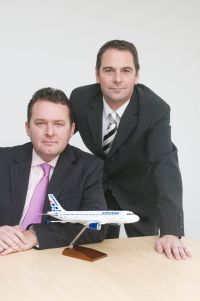 STRATEGIC, a new Brisbane (Australia) based airline, and operating in Europe under a French AoC, has created a UK commercial office at Gatwick Airport. The carrier, which claims to be the Australia’s newest international airline, will offer a range of service options including ACMI (Aircraft, Crew, Maintenance, Insurance), wet lease and full charter services. One of Strategic’s two Airbus A320-200 aircraft, is to be based in Europe, and the other utilised for its Australian operations. www.flystrategic.com
STRATEGIC, a new Brisbane (Australia) based airline, and operating in Europe under a French AoC, has created a UK commercial office at Gatwick Airport. The carrier, which claims to be the Australia’s newest international airline, will offer a range of service options including ACMI (Aircraft, Crew, Maintenance, Insurance), wet lease and full charter services. One of Strategic’s two Airbus A320-200 aircraft, is to be based in Europe, and the other utilised for its Australian operations. www.flystrategic.com
Continental finally goes flat
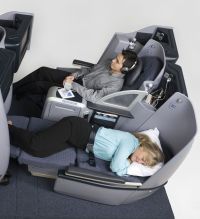 CONTINENTAL AIRLINES, in its first move as a member of Star Alliance, has put into service the lead aircraft fitted with its new BusinessFirst seats. These allow customers to lie completely flat, reclining 180 degrees and providing 6½ feet (2m) of sleeping space in the fully extended position. The seats feature 15.4-inch video monitors. Over the coming months the seats will be fitted on the airline's long haul Boeing 777s, 757-200s and 767-400 aircraft, and eventually on the new Boeing 787 fleet. The new seat will be also unveiled at WTM. www.continental.com
CONTINENTAL AIRLINES, in its first move as a member of Star Alliance, has put into service the lead aircraft fitted with its new BusinessFirst seats. These allow customers to lie completely flat, reclining 180 degrees and providing 6½ feet (2m) of sleeping space in the fully extended position. The seats feature 15.4-inch video monitors. Over the coming months the seats will be fitted on the airline's long haul Boeing 777s, 757-200s and 767-400 aircraft, and eventually on the new Boeing 787 fleet. The new seat will be also unveiled at WTM. www.continental.com
First UK Embraer Phenom
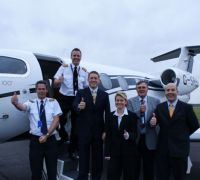 FLAIRJET has become the first UK operator of the Embraer Phenom 100 light jet. The initial aircraft (G-SRBN) touched down at it home base at Oxford Airport on Thursday 29 October. A second Phenom has now arrived. The four-passenger jet, the first personal jet built by a major aircraft manufacturer, is set to revolutionise executive travel within Europe, vastly cheaper to purchase and operate than even mid-size business jets, yet having virtually the same range and performance as its bigger brothers. The Phenom even has toilet facilities on board. www.flair-jet.com
FLAIRJET has become the first UK operator of the Embraer Phenom 100 light jet. The initial aircraft (G-SRBN) touched down at it home base at Oxford Airport on Thursday 29 October. A second Phenom has now arrived. The four-passenger jet, the first personal jet built by a major aircraft manufacturer, is set to revolutionise executive travel within Europe, vastly cheaper to purchase and operate than even mid-size business jets, yet having virtually the same range and performance as its bigger brothers. The Phenom even has toilet facilities on board. www.flair-jet.com
London to gain major new hotel?
 LONDON could have a new and large super luxury hotel if plans by the Qatar Investment Authority (QIA) are fulfilled. The US State Department has confirmed that it plans to sell its Grosvenor Square Embassy, a Grade II listed building, to QIA who foresee the 600-room property as the most prestigious accommodation in the capital. But readers should not get too excited. The Americans will not move out until their proposed Wandsworth legation is actually completed in 2017, and then Grosvenor Square will have a complete rebuild taking 2-3 years. Both buildings are subject to planning decisions. Times Online
LONDON could have a new and large super luxury hotel if plans by the Qatar Investment Authority (QIA) are fulfilled. The US State Department has confirmed that it plans to sell its Grosvenor Square Embassy, a Grade II listed building, to QIA who foresee the 600-room property as the most prestigious accommodation in the capital. But readers should not get too excited. The Americans will not move out until their proposed Wandsworth legation is actually completed in 2017, and then Grosvenor Square will have a complete rebuild taking 2-3 years. Both buildings are subject to planning decisions. Times Online
Qantas and Hong Kong
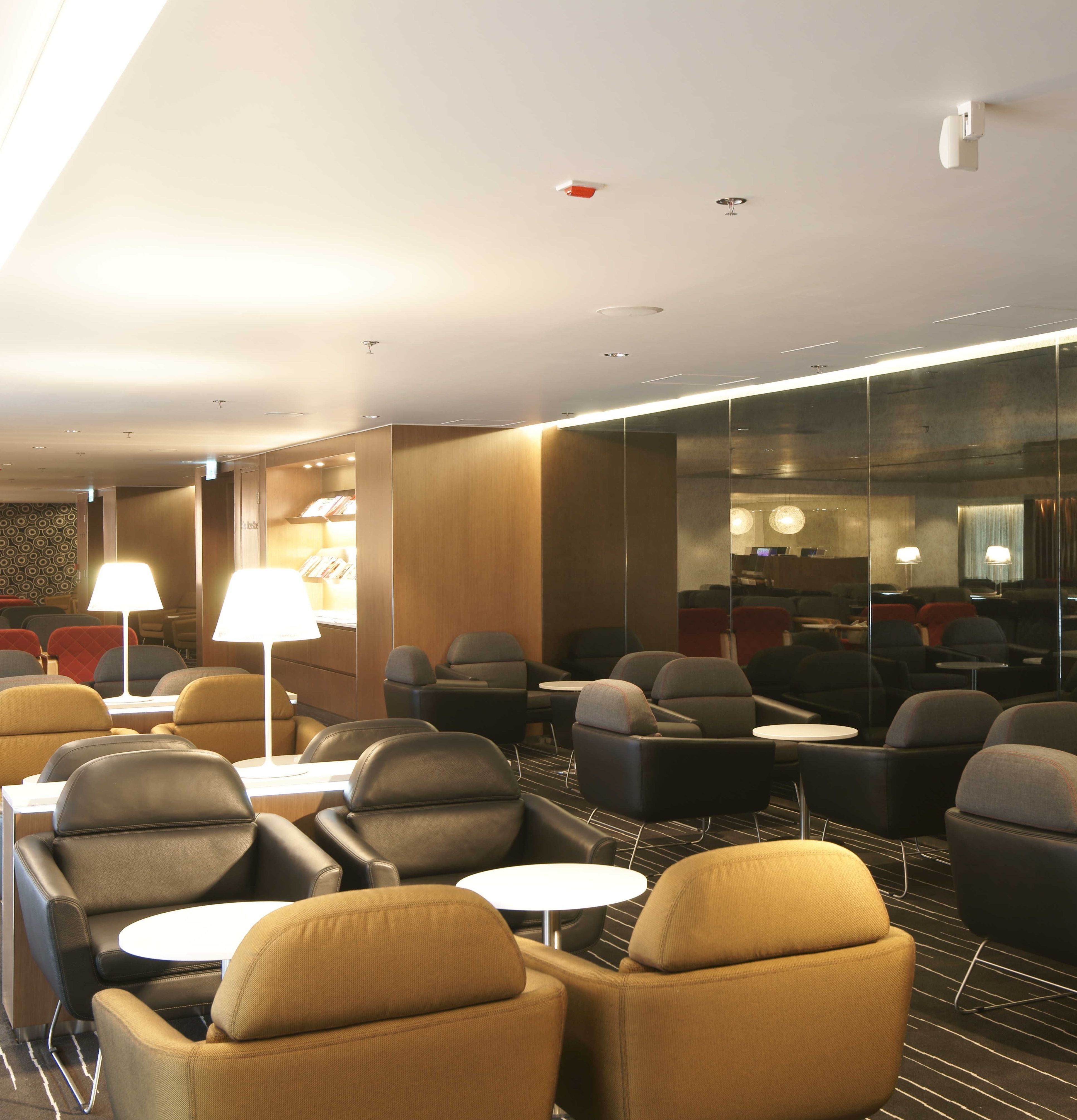 QANTAS (QF) has reopened its Business Lounge at Hong Kong (HKG), offering customers, what it describes as new levels of comfort and design. HKG is an important hub for QF, a connecting point from Australian cities to typically London and mainland China. For business travellers, QF have included 14 individual workstations each equipped with a PC, complimentary wireless access, and power and data points are located throughout the lounge. The First Lounge in Hong Kong is currently being expanded and refurbished, due to open next month in its existing location. www.qantas.com
QANTAS (QF) has reopened its Business Lounge at Hong Kong (HKG), offering customers, what it describes as new levels of comfort and design. HKG is an important hub for QF, a connecting point from Australian cities to typically London and mainland China. For business travellers, QF have included 14 individual workstations each equipped with a PC, complimentary wireless access, and power and data points are located throughout the lounge. The First Lounge in Hong Kong is currently being expanded and refurbished, due to open next month in its existing location. www.qantas.com
Travelodge to open seven hotels before Christmas
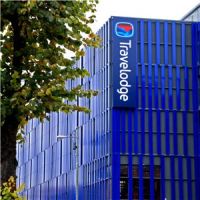 TRAVELODGE, the budget hotel chain is to open seven new properties in the run up to Christmas, including a 97-room establishment at Edinburgh Airport. The 2009 winter opening programme represents an investment of £22m and will also see new hotels in Bournemouth, Farnborough (Hants), Liverpool, Macclesfield, Newquay and Norwich. www.travelodge.co.uk
TRAVELODGE, the budget hotel chain is to open seven new properties in the run up to Christmas, including a 97-room establishment at Edinburgh Airport. The 2009 winter opening programme represents an investment of £22m and will also see new hotels in Bournemouth, Farnborough (Hants), Liverpool, Macclesfield, Newquay and Norwich. www.travelodge.co.uk
TOM WHEATCROFT
Tom Wheatcroft has died at the age of 87 after a long illness. Perhaps not as well known on the international stage as other characters engaged in motor sport, and in particular the world of Formula One, the genial East Midlander will always be associated with Donington Park and his GP collection. A local man, successful in business as a builder, and a keen motor racing enthusiast, he purchased Donnington Park and its motor racing track in 1970. Using his own funds he developed it over the years with the European Grand Prix of 1993, won by Ayrton Senna, perhaps the pinnacle of its fame. The outstanding car in the collection is the blue Rob Walker Lotus 18 in which Stirling Moss won the 1961 Monaco Grand Prix. Also on display is Jim Clark’s championship winning Lotus 25, although there was a dispute with Colin Chapman over this car, said only to be a loan. In more recent times Wheatcroft leased out the circuit to an independent company called Donington Ventures Ltd, whose failure to raise the funds for the 2010 British Grand Prix raises questions over the circuit’s future.
HAPPY TALK: Sharp Story
A baby croc caused chaos on a flight to the Egyptian capital Cairo when it escaped from a passenger's luggage, according to airport officials.
Passengers screamed as the crocodile, which was about 20 inches long, scuttled down the cabin before it was captured by crew members.
All passengers on the Egypt Air flight were asked about the reptile, but none owned up to bringing it on board.
The crocodile was handed to local authorities when the plane landed.
Reports said it will be donated to a local zoo.
FROM BBC NEWSROUND
Aer Lingus ups London services
 AER LINGUS will add a fourth daily service between Belfast International and Heathrow for next summer. It will even out the schedules according to the Dublin-based airline. There are currently 30 flights per day between the two Northern Ireland airports and the five serving London. Aer Lingus says that its Belfast base has been a big success in the two years (December 2007) since it opened with over 1.3m booking flights. www.aerlingus.com
AER LINGUS will add a fourth daily service between Belfast International and Heathrow for next summer. It will even out the schedules according to the Dublin-based airline. There are currently 30 flights per day between the two Northern Ireland airports and the five serving London. Aer Lingus says that its Belfast base has been a big success in the two years (December 2007) since it opened with over 1.3m booking flights. www.aerlingus.com
bmibaby restructures
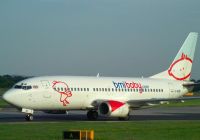 BMIBABY, now owed 100% by Lufthansa, has announced a restructuring programme that will see it focus its activities and efforts on routes where it believes there are clear indications and prospects for future growth and development. Axed for 2010 are five aircraft from the current 17 strong fleet together with 54 pilot and 82 cabin crew positions at Birmingham, Cardiff and Manchester airports and 22 management and support positions at the head office. On the positive side new routes and staffing will be added at East Midlands Airport. www.flybmibaby.com
BMIBABY, now owed 100% by Lufthansa, has announced a restructuring programme that will see it focus its activities and efforts on routes where it believes there are clear indications and prospects for future growth and development. Axed for 2010 are five aircraft from the current 17 strong fleet together with 54 pilot and 82 cabin crew positions at Birmingham, Cardiff and Manchester airports and 22 management and support positions at the head office. On the positive side new routes and staffing will be added at East Midlands Airport. www.flybmibaby.com
Cyprus opens new terminal
 LARNACA AIRPORT (Cyprus) has a new terminal replacing a makeshift building erected in 1975. Cyprus has three international airports – Larnaca, which replaced Nicosia at the time of the division of the island, Papos to the west, and Ercan in the Turkish sector. The new facility, which doubles capacity, features include 67 check-in counters, 16 air bridges, departure and arrivals situated on different levels and parking for 2,650 vehicles. www.cyprusairports.co.uk
LARNACA AIRPORT (Cyprus) has a new terminal replacing a makeshift building erected in 1975. Cyprus has three international airports – Larnaca, which replaced Nicosia at the time of the division of the island, Papos to the west, and Ercan in the Turkish sector. The new facility, which doubles capacity, features include 67 check-in counters, 16 air bridges, departure and arrivals situated on different levels and parking for 2,650 vehicles. www.cyprusairports.co.uk
Iberia attacked by The Independent
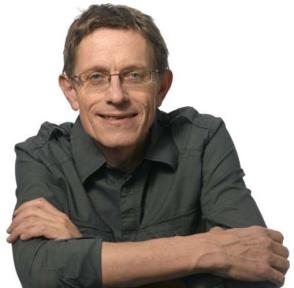 IBERIA has come in for some serious criticism by Simon Calder, travel writer for the Independent, and regular BBC pundit. Calder says that if BA were to merge with Iberia it is widely believed that the resultant airline will have its headquarters in Madrid, a condition of the deal making. AERBT flew on Iberia last month, the €873 Economy Class return from Heathrow to Barcelona paid for by the host, with no onboard courtesy refreshments supplied at all, although sandwiches were available priced at €7.5. Calder noted visitors to the recent ABTA convention in the capital of Catalonia described the airline as "easyJet without the smiles". Readers can make up their own mind but it is widely accepted that another Spanish purchase of a major UK air travel component, BAA by Ferrovial, has been less than successful. Simon Calder
IBERIA has come in for some serious criticism by Simon Calder, travel writer for the Independent, and regular BBC pundit. Calder says that if BA were to merge with Iberia it is widely believed that the resultant airline will have its headquarters in Madrid, a condition of the deal making. AERBT flew on Iberia last month, the €873 Economy Class return from Heathrow to Barcelona paid for by the host, with no onboard courtesy refreshments supplied at all, although sandwiches were available priced at €7.5. Calder noted visitors to the recent ABTA convention in the capital of Catalonia described the airline as "easyJet without the smiles". Readers can make up their own mind but it is widely accepted that another Spanish purchase of a major UK air travel component, BAA by Ferrovial, has been less than successful. Simon Calder
OAG November figures
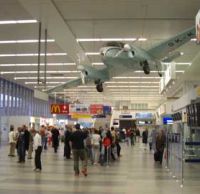 OAG reports that airlines worldwide for the month of November will operate 1% more flights as compared to November 2008. In some ways the OAG figure is a more accurate appraisal of airline activities as it shows the actual seats on offer rather than passengers flow. The OAG statistics covers all airline rather than just IATA members. The current star is the Middle East is with flights up by 19% and seats on offer a dramatic increase of 23% over the same period as last year. North America, the largest market of all, shows little signs of recovery with flights down 2% and seats by 3%. On the normally most lucrative North Atlantic it is 4% and 3% respectively. www.oag.com
OAG reports that airlines worldwide for the month of November will operate 1% more flights as compared to November 2008. In some ways the OAG figure is a more accurate appraisal of airline activities as it shows the actual seats on offer rather than passengers flow. The OAG statistics covers all airline rather than just IATA members. The current star is the Middle East is with flights up by 19% and seats on offer a dramatic increase of 23% over the same period as last year. North America, the largest market of all, shows little signs of recovery with flights down 2% and seats by 3%. On the normally most lucrative North Atlantic it is 4% and 3% respectively. www.oag.com
Ryanair profits
 RYANAIR has posted an 80% rise in first-half profits to €387m (£347) and says it could reverse its long-standing strategy of rapid growth and distribute cash to shareholders instead if negotiations with Boeing for 200 aircraft, partly for expansion and partly to replace older planes, fail. The announcement has had a negative effect on shares and after a little burst they are now at €2.88 (with a 12-month low of €2.40) well down on the 52 week high of €3.88 and about half of the best ever. The airline claims to still be winning business from the three major European carriers, clearly passengers not put off by the need to often use out of the way and often less sophisticated airports. www.ryanair.com
RYANAIR has posted an 80% rise in first-half profits to €387m (£347) and says it could reverse its long-standing strategy of rapid growth and distribute cash to shareholders instead if negotiations with Boeing for 200 aircraft, partly for expansion and partly to replace older planes, fail. The announcement has had a negative effect on shares and after a little burst they are now at €2.88 (with a 12-month low of €2.40) well down on the 52 week high of €3.88 and about half of the best ever. The airline claims to still be winning business from the three major European carriers, clearly passengers not put off by the need to often use out of the way and often less sophisticated airports. www.ryanair.com
United to Africa
 UNITED AIRLINES, headquartered in Chicago, has announced that the airline will inaugurate its first-ever service from Africa in 2010, with one daily, same-plane service from Accra and Lagos to Washington DC. The carrier also will extend its existing daily Kuwait – Washington DC. flight to include Bahrain, and will offer a new non-stop flight between Brussels and Chicago. Introduction of all of the new services is subject to government approval. United are also to bring in new uniforms designed by American fashion leader Cynthia Rowley but tantalisingly no photographs are available as yet. www.united.com
UNITED AIRLINES, headquartered in Chicago, has announced that the airline will inaugurate its first-ever service from Africa in 2010, with one daily, same-plane service from Accra and Lagos to Washington DC. The carrier also will extend its existing daily Kuwait – Washington DC. flight to include Bahrain, and will offer a new non-stop flight between Brussels and Chicago. Introduction of all of the new services is subject to government approval. United are also to bring in new uniforms designed by American fashion leader Cynthia Rowley but tantalisingly no photographs are available as yet. www.united.com
ON TOUR: Supersonic private jets
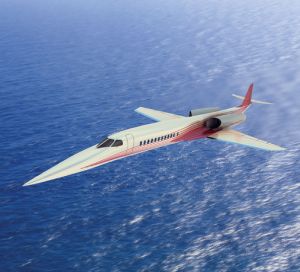
“Is Mach 1.6 good enough,” questioned Oscar Garcia, Chairman of US-based InterFlight Global speaking about supersonic business jet travel and definitely on theme at Quaynote Communications’ 3rd annual Future of Business Jets Conference in London last week. The conference highlighted that private jet clients already enjoy luxury cabins and efficiency with a whole raft of aircraft available for charter, but supersonic speed is the remaining box not yet ticked.
Andrew Hoy, Managing Director, ExecuJet Aircraft Trading, gave an update on the Aerion Super Sonic Business Jet (SSBJ) which looks set to be first to market in 2015 – if a manufacturer confirms it will build it – and here, discussions are progressing, he said. Furthermore, ExecuJet, the sales representative of the aircraft for most of the world (excluding America) confirmed there were already 50 letters of intent from private individuals, along with an undisclosed airline, who have placed MoUs for the $80m 12-seat jet. It may well pick up more sales at the Dubai Airshow next week. David Macdonald, Sales Director for Air Partner plc, agreed his clients are already showing interest in flying on the aircraft. “As experience has shown,” he said, “if manufacturers produce something nice, people will buy it.”
Sub-orbital RocketPlane
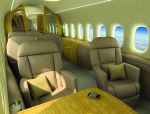 So while the SSBJ may well be a reality, InterFlight Global really is definitely futuristic. It is advocating the development of a mutant-style sub-orbital RocketPlane (using a solid propellant fuel made from a combination of laughing gas and rubber!). The cost of such development – an anticipated $2.5bn. So it seems for the present, a speed of 1.6 Mach, the speed Aerion is working toward for FAA certification, is enough. (Only in the US are speeds restricted to below Mach 1). The company also says its jet will be compliant with Stage 4 regulations and the latest emissions standards.
So while the SSBJ may well be a reality, InterFlight Global really is definitely futuristic. It is advocating the development of a mutant-style sub-orbital RocketPlane (using a solid propellant fuel made from a combination of laughing gas and rubber!). The cost of such development – an anticipated $2.5bn. So it seems for the present, a speed of 1.6 Mach, the speed Aerion is working toward for FAA certification, is enough. (Only in the US are speeds restricted to below Mach 1). The company also says its jet will be compliant with Stage 4 regulations and the latest emissions standards.
However, for the rest of the business jet community the future seems far away from supersonic with new regulations, taxes and negative publicity hampering development. Countering the recent negative publicity brought about earlier this year by the three top auto executives flying into DC in their private jets to ask for funding, Brian Humphries Chief Executive of the EBAA presented persuasive evidence revealing just how important to a region’s economy business aviation is.
According to a study by Price Waterhouse Coopers, 2007 saw business aviation contribute $19.2bn to the European economy, both directly and indirectly. A total $12bn of this moved through the European heart of Germany, France and the UK. Corporate activity represents 80% of the business and as Humphries, along with others, argued, business aviation is about productivity, generating commerce and ensuring long term economic growth in a sustainable manner. It is not about strawberries and champagne. That’s reserved for the 3% leisure users,” he said. Air Partner highlighted that its client base of leisure users has actually increased from 5% five years ago to 30% today. “These people have made a lifestyle choice switching to private jet travel. The elite and wealthy will be true to it,” he said.
ARINC Managing Director EMEA Dave Poltorac highlighted that increasingly business jet clients are coming to them before making a decision on which jet they buy to ensure they have good inflight communications – another important aspect in the future of business jet travel, delegates heard. Many clients will want to replicate their office at 31,000 ft. There is an increasing array of packages/communications channels now available to keep connected dependent on range and speed of sending messages. Satellite connection equipment is getting smaller, faster and less expensive and if business users want to be able to email and check messages on their Blackberry, there are a number of options, he added.
“Green shoots, or brown leaves,” challenged conference chairman Sean Gates of Aviation lawyers Gates and Partners as presentations were made indicating the beginning of the end of the downturn for business aviation. The year 2009 saw the business jet market in a very depressed state with around 18% of the global fleet grounded and for sale, highlighted Embraer’s Claudio Camelier. This has now reduced to 16.9% and in recent months worldwide inventory has declined. On the upside, delegates heard that banks are beginning to consider financing again, albeit with stricter terms. Whilst the light jet market movements remain distinctly flat, the mid and heavy jet movement figures are increasing.
Entry Level Jet
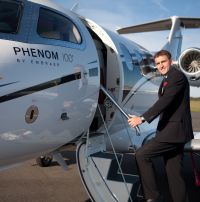 The new Very Light Jet or Entry Level Jet as the OEMs prefer to call it, is aiming to broaden the customer base for corporate aviation offering a lower entry cost for private jet charter. During the conference Air Partner announced it has added the Very Light Jet as one of two new categories on its popular 25-hour prepaid JetCard, becoming the first in the industry to do so. And London-based Oriens Advisors, the newly formed light jet consulting business, confirmed it is looking to tap emerging markets in Central Europe and with the recent formation of Central Europe’s first Business Aviation Development Association, headed by Dagmar Grossman, expansion is likely there.
The new Very Light Jet or Entry Level Jet as the OEMs prefer to call it, is aiming to broaden the customer base for corporate aviation offering a lower entry cost for private jet charter. During the conference Air Partner announced it has added the Very Light Jet as one of two new categories on its popular 25-hour prepaid JetCard, becoming the first in the industry to do so. And London-based Oriens Advisors, the newly formed light jet consulting business, confirmed it is looking to tap emerging markets in Central Europe and with the recent formation of Central Europe’s first Business Aviation Development Association, headed by Dagmar Grossman, expansion is likely there.
Less optimistically, Andrew Hoy stated “flat is the new growth,” discussing the existing market. He confirmed the view of several speakers that looking to China, India and other developing markets will ensure long term sustainability for many business aviation companies. In 2005 China had just 13 aircraft in its business aviation fleet, yet by the end of 2009 it is anticipated to have 90 and the number will just continue to increase exponentially with current predictions seeing a fleet of 300 by 2011, he said.
The one dark shadow hovering over these developing areas is infrastructure. Andrew Hoy commented “aircraft need love on the ground,” and currently there is a real lack of facilities in both India and China. Peter Edwards of Jet Aviation expanded on this arguing emerging markets have significant challenges to face in terms of culture, tax, understanding and development of regulatory structures. Both Hoy and Edwards agreed that integrated aviation businesses that work with OEMs and use local knowledge are those that will become successful in the emerging markets. Interestingly, the CAA in Singapore attended the conference to learn more about trends in Europe.
Emissions Transfer Scheme
 These areas will also be challenged, just as the rest of the world is, by complicated issues of environmental protection, a subject hotly debated by delegates and speakers alike. Stephen Boyle from the UK’s Department of Transport commenting on the impending Emissions Transfer Scheme (ETS) controversially stated “it is not a tax.” However the business aviation community believes it is, and they argue they are being singled out unfairly because they operate in a completely different way to commercial airlines. The ETS may see business jet costs increase by up to £200 per hour of flying time. As Sean Gates commented, “If it smells like a tax, walks like a tax, and quacks like a tax, then it probably is one.” With the average business jet in Europe being less than two years old, offering point to point city pairing poorly served by scheduled airliners, and flying to task not to schedule, there are strong arguments to develop a system more akin to business aviation’s methods of operation, delegates heard.
These areas will also be challenged, just as the rest of the world is, by complicated issues of environmental protection, a subject hotly debated by delegates and speakers alike. Stephen Boyle from the UK’s Department of Transport commenting on the impending Emissions Transfer Scheme (ETS) controversially stated “it is not a tax.” However the business aviation community believes it is, and they argue they are being singled out unfairly because they operate in a completely different way to commercial airlines. The ETS may see business jet costs increase by up to £200 per hour of flying time. As Sean Gates commented, “If it smells like a tax, walks like a tax, and quacks like a tax, then it probably is one.” With the average business jet in Europe being less than two years old, offering point to point city pairing poorly served by scheduled airliners, and flying to task not to schedule, there are strong arguments to develop a system more akin to business aviation’s methods of operation, delegates heard.
“Nothing flies without an airport,” stated Bud Slabbaert from St Gallen Airport in Switzerland and with increasing congestion at the major airports the future for regional airports looks promising. Steve Jones Managing Director of Oxford Airport commented “aviation needs regional airports to relieve the congestion,” but warned “airports need to think laterally to be a viable long term proposition,” citing how Oxford has developed not only its airport infrastructure to cater for smaller scheduled flights – an example being Swiss regional Baboo starting an Oxford – Geneva weekly service this winter, but it also operates as a real estate company with over 25 other businesses based on the airport site.
Inflite Jet Centre, the Stansted FBO confirmed at the conference a creative way of seeing that its business jet operators don’t lose out on purchasing duty free or luxury goods. In September it ratified a deal with BAA and World Duty Free whereby private jet passengers can select their duty free via the World Duty Free website and collect on their return via Inflite. The deal even extends to Hamleys, the premier toy store. “We’ve had a rocking horse in our terminal and several clients have said they want to order it for Christmas,” said Director Penny Stephens. Inflite regularly caters for private charters using aircraft up to 200-seats, but as a result of its unique deal with BAA, crew and passengers flying out on smaller Learjet-sized jets benefit. Inflite is the first FBO to introduce such a scheme. Other FBOs present (namely Assistair and Oxfordjet) said they do not have the passenger volumes for such a scheme, but agreed product placement and aligning the FBO with a complementary, luxury brand is a good idea. Omega is one example of a company keen to work with FBOs to expand their reach.
Ironically at a conference entitled “The Future of Business Jets” there was a news announcement from BAE that they have just signed an order for a BAE 146-200 to be converted into a VIP 46-seat executive shuttle role from the UK-based Gill Group. “ABJ sales have really taken off in the past 18 months,” said the company’s Stewart Cordner. British companies Design Q and Inflite Engineering will provide the design and aircraft modification work, respectively. The typical customer purchasing an Avro BJ conversion is often a first time owner who eventually will upgrade to a newer jet, Cordner said. “Right now the time is great for conversion aircraft, it’s the value proposition of converting airliners to luxury VIP configuration that is so compelling.”
Jane Stanbury
Emerald Media Spain
jane@emeraldmedia.co.uk
www.quaynote.com
www.execujet.net
www.interflightglobal.com
www.airpartner.com
www.arinc.com
www.ebaa.org


